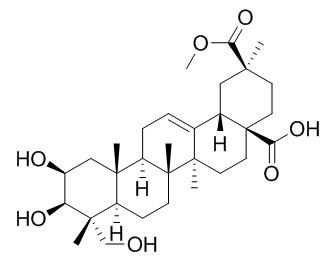 |
Treatment:
American Pokeweed
- Common Name: American Pokeweed
- Family: Phytolaccaceae
- Scientific Name:Phytolacca americana
- Habitat: Eastern Deciduous Forest/Tall Grass Prairie
- Active Chemical Ingredients: Phytolaccagenin
- Uses: anti-inflammatory, cleanses the blood, analgesic
- Preparation: Eat the boiled berries, CAUTION! If eaten raw, they are poisonous!!!
 |
| phytolaccagenin |
Treatment:
Horse-Nettle
- Common Name: Horse-Nettle
- Scientific Name: Solanum carolinense
- Family: Solanaceae
- Habitat: Tall grass prairie
- Active Chemical Ingredients: solamargine, solasonine
- Uses: sedative, helps convulsions, provides necessary minerals for bone repair
- Preparation: tea from leaves
References:
- (n.d.). Retrieved September 6, 2015, from http://s3.amazonaws.com/rapgenius/RmMrKF1Q4ygU1vuUpZk2_rg8.jpg
- Broken bone: MedlinePlus Medical Encyclopedia. (n.d.). Retrieved September 6, 2015.
- (n.d.). Retrieved September 8, 2015, from http://www.giftpflanzen.com/Copyright_giftpflanzen.com/phytolaccagenin.gif
- Pokeweed. (n.d.). Retrieved September 8, 2015, from http://altnature.com/gallery/pokeweed.htm
- Pokeweed. (n.d.). Retrieved September 8, 2015, from http://www.naturalremedies.org/pokeweed/
- Pokeweed Uses, Benefits & Dosage - Drugs.com Herbal Database. (n.d.). Retrieved September 8, 2015.
- Pokeweed, American (Phytolacca americana): The Jekyll and Hyde Plant. (n.d.). Retrieved September 8, 2015.
- WW Misc. (n.d.). Retrieved September 8, 2015, from http://www.catnapin.com/WildFlowers/Flowers-W/wwMisc.htm
- (n.d.). Retrieved September 10, 2015, from http://patentimages.storage.googleapis.com/WO2000061153A1/imgf000004_0001.png
- (n.d.). Retrieved September 10, 2015, from http://file.scirp.org/Html/3-25100074729c4e-70ed-4afb-bcc6-a523006499b5.jpg
- Herbs for Injuries and Broken Bones. (n.d.). Retrieved September 10, 2015.
- Horse Nettle Solanum carolinense - Survival School. (n.d.). Retrieved September 10, 2015.
- Solanum carolinense - Natural medicine facts. (n.d.). Retrieved September 10, 2015.
- (n.d.). Retrieved September 10, 2015, from http://tyson.wustl.edu/flora/flora/horsenettle.jpg





No comments:
Post a Comment